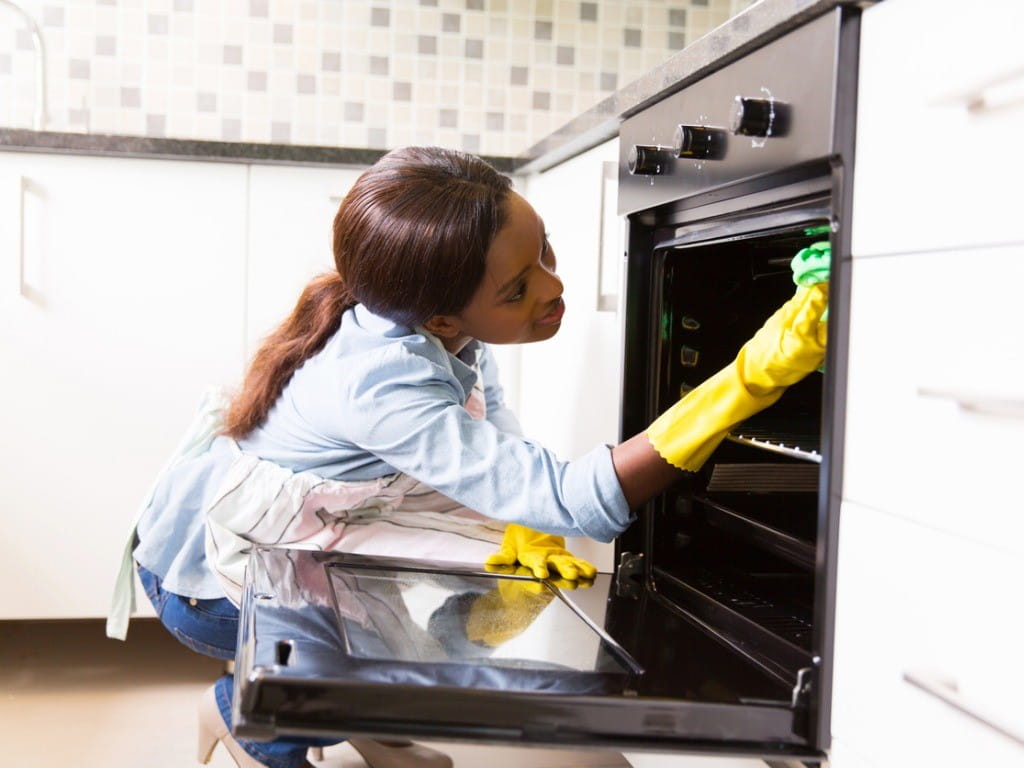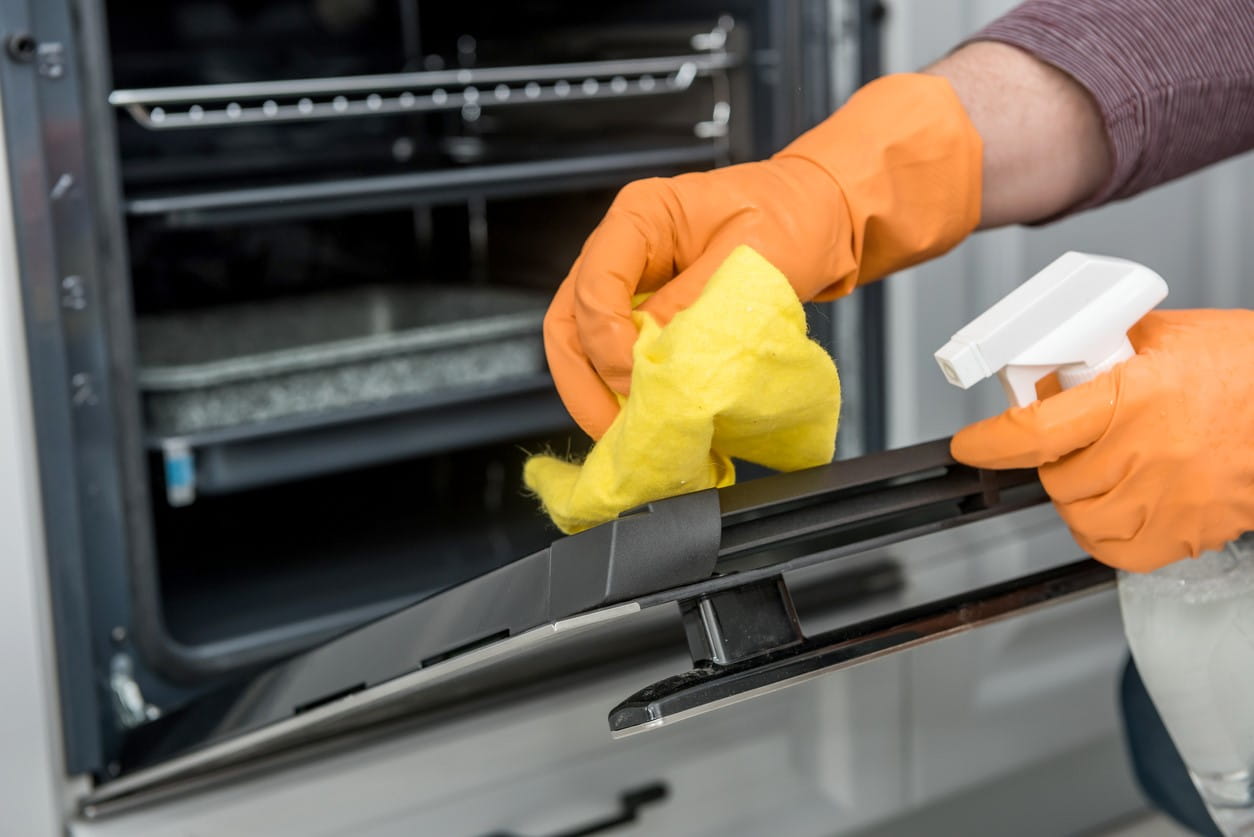Using Oven Cleaners Safely

The Bottom Line
Oven and grill cleaners are usually highly caustic. Upon contact with any tissue, they can cause damage ranging from irritation to severe burns.

How do oven cleaners work?
Oven cleaners are typically sprayed onto the oven surfaces and allowed to sit with the oven door closed for a specified period of time, often between 10 minutes and 2 hours. The solution is designed to degrade baked-on food and grease and then thicken it so that it can be more easily wiped away. Oven cleaners are usually very caustic. This is what allows the solution to degrade and dissolve the hardened debris in ovens and on grills. Oven and grill cleaners intended to be used in commercial settings like restaurants can be more concentrated and stronger than those intended for home use. The caustic nature of oven cleaners means that they can cause serious burns. The length of time an oven cleaner is in contact with the tissues affects the extent of injury. This is why it's crucial to decontaminate right away if exposure occurs.Is oven cleaner toxic if swallowed?
If swallowed, oven cleaners can cause vomiting and burns to the lips, mouth, throat, and further down in the digestive tract, like the esophagus and stomach. Symptoms of burns can vary depending on where the burn is. For instance, a burn on the lips can cause swelling, redness, and blistering. This can also be seen in the mouth and throat. A chemical burn in the throat can be life-threatening because it can lead to swelling, which might block the windpipe. A burned throat can also lead to drooling, as the person might be unable to swallow.Can an oven cleaner burn your skin?
Oven cleaner on the skin can cause redness, peeling, blistering, and swelling. If the solution is allowed to sit on the skin, it can start burning through the layers of the skin, causing deeper and more severe burns.Inhaling oven cleaner
If inhaled, oven cleaners can be irritating to airways, causing symptoms ranging from coughing and chest pain to shortness of breath.
Can an oven cleaner damage your eyes?
If in the eyes, oven cleaners can cause corrosion and ulceration of the eye tissues.
First aid actions if exposed to an oven cleaner
- If swallowed: Rinse the mouth thoroughly. If it has only been a few minutes since the ingestion, drink a few sips of water or milk. Then use the webPOISONCONTROL online tool for guidance, or call Poison Control at 1-800-222-1222.
- If on the skin: Immediately rinse with running water for at least 20 minutes. Take off any clothing with the product on it while you're rinsing. Then use the webPOISONCONTROL online tool for guidance or call Poison Control at 1-800-222-1222.
- If inhaled or exposed to fumes: Move away from the source and get into fresh air immediately. Then use the webPOISONCONTROL online tool for guidance or call Poison Control at 1-800-222-1222
- If in the eyes: Immediately rinse with running water for at least 15–20 minutes. Then call Poison Control at 1-800-222-1222 for further guidance.
If you're concerned about exposure to an oven cleaner, follow the first aid instructions above and then check the webPOISONCONTROL online tool or call Poison Control at 1-800-222-1222 for guidance.
Serkalem Mekonnen, RN, BSN, MPH
Certified Specialist in Poison Information
Revised William G. Troutman, PharmD
Professor of Pharmacy Emeritus
Poison Control Media Information
Did you find this page helpful? If so, we need your support. Poison Control is in constant competition with misinformation online. Links to www.poison.org or our webPOISONCONTROL triage tool from other websites and blogs help internet searchers quickly find accurate information and Poison Control’s contact information in an emergency. If you use the content from this page, please provide attribution via a link back to this page, www.poison.org, or https://triage.webpoisoncontrol.org/#!/exclusions. By doing so, you could save a life. Thank you!
Poisoned?
Call 1-800-222-1222 or
Prevention Tips
- Never transfer oven cleaners out of their original containers.
- Store oven cleaners safely, locked out of sight and reach of children and pets and with the cap closed tightly.
- Read the label carefully and follow the manufacturer's directions exactly.
- Avoid direct contact with the product. Wear gloves and other types of personal protective equipment (including protective clothing for upper arms, safety glasses, and face mask) as specified by the manufacturer.
- Avoid breathing in the product by using it in a well-ventilated area. Open windows if the label advises to do so.
- Do not use oven cleaners made for commercial settings, such as restaurants.
This Really Happened
A 6-year-old girl drank an oven-and-grill cleaner that had been transferred into a cup. Within minutes, she was vomiting and complaining of severe pain. Her tongue looked red, and she was drooling. She was taken to an emergency room where she received medication for pain and nausea and was started on IV fluids. The physician ordered "nothing by mouth," which means she could not have any food or oral fluids. A gastrointestinal specialist was consulted. With the knowledge that this product can cause severe tissue burns, and because the girl's initial symptoms were consistent with this, she was examined by endoscopy. This process consists of placing a flexible tube with a light and camera on its end inside the throat and down into the stomach to determine the location and severity of injury. The endoscopy showed that the girl had sustained a burn in her digestive tract, so the "nothing by mouth" order continued, and she received medication to help the burn heal, along with pain medications to improve comfort. The girl's symptoms improved over the next week and burn continued to heal. She was discharged home after 13 nights in the hospital.For More Information
References
Mason RW, Slaughter RJ. Inquiries to the New Zealand Poisons Centre concerning exposures to aerosol oven cleaners [abstract]. Clin Toxicol (Phila). 2015;53:322.
Poisoned?
Call 1-800-222-1222 or
Prevention Tips
- Never transfer oven cleaners out of their original containers.
- Store oven cleaners safely, locked out of sight and reach of children and pets and with the cap closed tightly.
- Read the label carefully and follow the manufacturer's directions exactly.
- Avoid direct contact with the product. Wear gloves and other types of personal protective equipment (including protective clothing for upper arms, safety glasses, and face mask) as specified by the manufacturer.
- Avoid breathing in the product by using it in a well-ventilated area. Open windows if the label advises to do so.
- Do not use oven cleaners made for commercial settings, such as restaurants.
